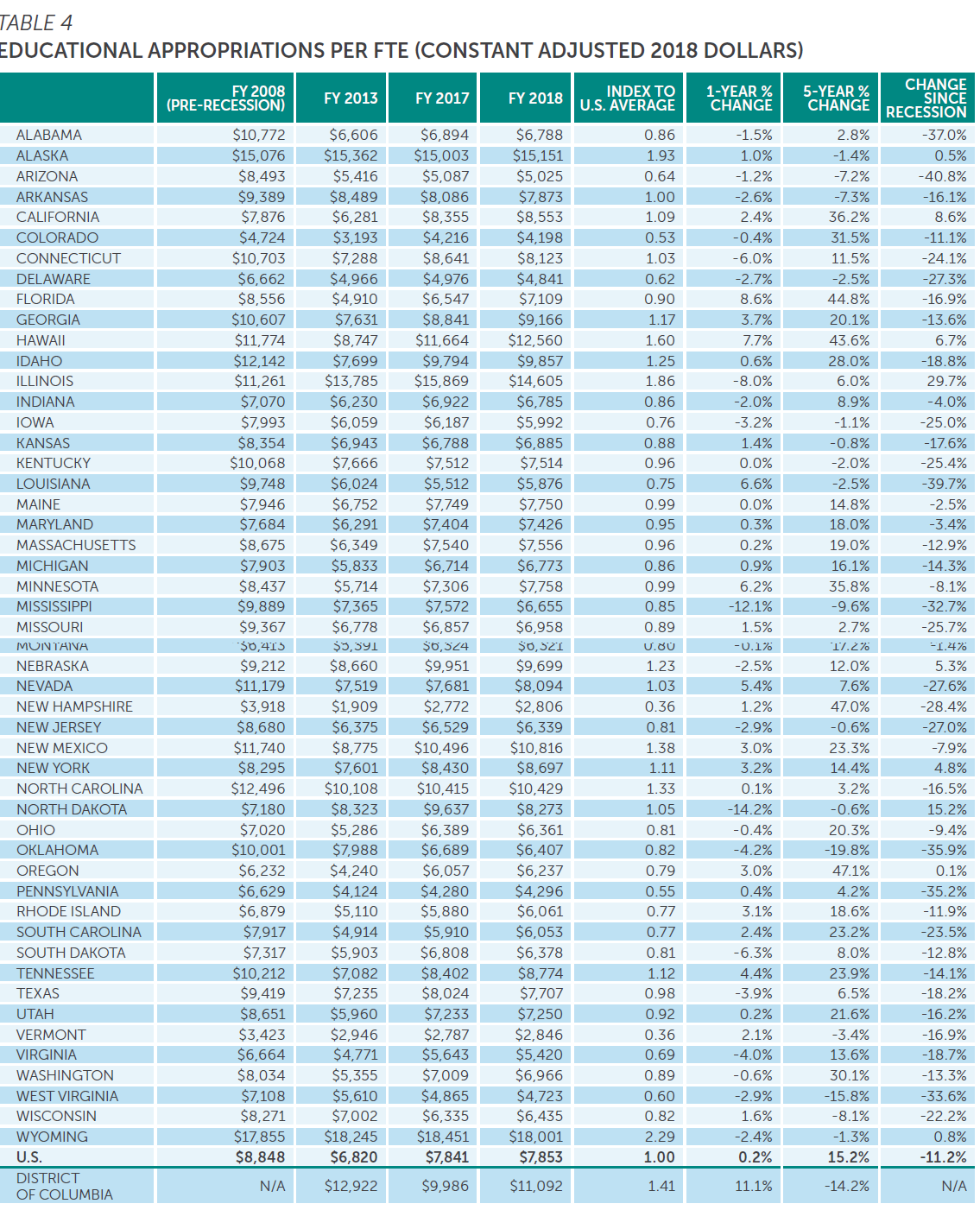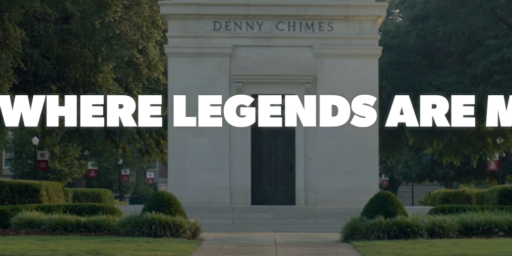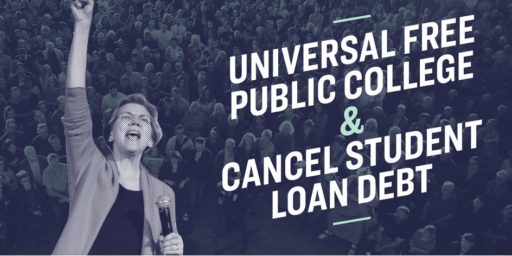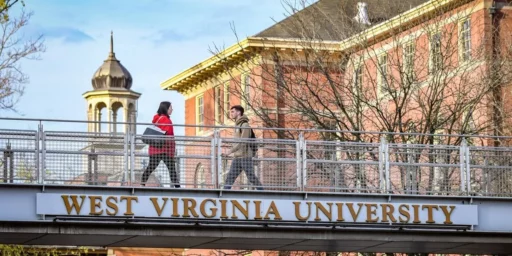41 States’ Higher Ed Funding Down Since 2008
Per-student investment in public colleges has not recovered from the Great Recession.

While the Great Recession has long been over, there’s one key way in which we still have not recovered.
A decade after the 2008 recession, fewer than one in five states has fully recovered when it comes to per-student appropriations for higher education.
A new study finds that just nine states have bounced back from pre-recession funding levels, and another nine have yet to increase per-student funding to even the low point of the recession.
In the middle: 32 states that have higher per-student appropriations than at their low point in 2012 or 2013, but which now fund postsecondary education at a lower level than their pre-recession high of 2007 or 2008.
The findings suggest that even as many state higher education systems have marked several years of annual funding increases, recovery has been highly uneven and has largely failed to keep up with expanding enrollments over the decade.
[…]
The nine states that have recovered in per-student funding over that decade: Alaska, California, Hawaii, Illinois, New York, North Dakota, Oregon, Wisconsin
and Wyoming. And even among these nine, caveats apply: in Oregon, for instance, local funding made a difference in what was otherwise flat state-level funding. In two others — Illinois and North Dakota — per-student appropriations never declined during the recession. In Illinois, that was due to the state’s efforts to backfill an underfunded pension system, while in North Dakota state appropriations in 2012 were actually higher than in 2008.Inside Higher Ed, “Partial, and Uneven, Recovery From Recession”
The accompanying chart is quite useful:

And, yes, these are in constant (2018) dollars. My former home state of Alabama, where I both completed three degrees as a student and taught as a professor (and where co-blogger Steven Taylor serves as a college dean), is down more than a third over the decade. My current home state of Virginia, which has some of the finest public universities in the country, is down nearly a fifth.
The upshot is a trend that began well before the recession continues apace:
[P]ublic higher education systems now rely more than ever on funding from students and families. More than half of states last year looked to tuition to a greater extent than they did taxpayer-supported appropriations.
In all, 27 states are now rely on tuition for more than 50 percent of their public college revenue, down from 28 last year, according to the new report.
For good and ill—and I think mostly the latter—state and local governments took the biggest hit from the Great Recession. Most have not bounced back. With education being the biggest line item in most state budgets (usually competing with prisons for that honor) it’s not that surprising that we’re investing less in our colleges and universities.
At the public policy level, we’re both encouraging our kids to prepare for and attend college and making it much less desirable for them to do so.
Some, notably Glenn Reynolds of






This information is not very useful because it doesn’t show how much private and federal donations are filling the gap. Universities have much more money now than they did ten years ago mainly due to those two factors (and they keep raising our overhead rates as well). So it’s not clear at all that this is driving tuition hikes nearly as much as being claimed. Notably, the principle cause of that is administrative bloat (Mitch Daniels has kept Purdue’s tuition frozen for seven years, mostly by shrinking admin, but also by enrolling more out-of-state or foreign students). I often jokes that our universities are becoming administrations with sidelines in teaching and research.
Not saying this isn’t something to worry about. But I keep seeing this little piece of the picture instead of the entire canvas.
Education spending is being crowded-out in state budgets by ever-increasing healthcare costs and pension liabilities which are exacerbated, in many states, by demographics. There are no easy solutions.
A liberal arts college with 11oo students probably doesn’t need six deans. But such places have them.
It shows what a state and its populace values. Why am I not surprised that Arizona is down 40%, with its heavy population of retirees with no children or grandchildren enrolled in the local schools? And does the number include spending on new sports stadiums and coaches with 7 or 8 figure salaries? Because they have been going up in the same period and if you take those costs out of the budget it would go down even more so, at least in the failed Trump states.
And this is why I make my students calculate several different Student Loan repayment schedules using various assumptions every semester when I teach the unit on compound interest and the time value of money.
It is also why I hand a list of the technical and workforce education degrees, certificates, and programs that we offer at our community college, including cost of attendance, time to completion, median salary, and job growth outlook.
Sadly, I am unable to convince the vast majority of the economically vulnerable among them that anything less than a College Degree is the best career preparation for them. They have been utterly programmed to believe that, even though they are unable to explain exactly *how* it is going to work out well for them even in the face of an actual Income Sensitive Loan Repayment Schedule or a Net Present Value analysis.
It is maddening.
@Hal_10000:
That’s really a separate issue. States are divesting from higher ed. Most of what the Feds kick in—and the amount now surpasses what the states supply—comes in the form of Pell grants and research grants.
@MarkedMan: Sports stadia and the bulk of salaries for coaches in revenue sports comes are privately funded.
@Gromitt Gunn: Yup. I wasn’t cut out to be a plumber but the pay’s definitely better.
I got my Master’s from UCLA in the very late ’90’s…best bargain ever…cost me next to nothing for three years.
Not for nothing…but what’s with the picture?
The Paramount in Austin???
That doesn’t look like many University Theatres I’ve been in.
@Daryl and his brother Darryl: Fixed. I liked the image but didn’t pay that much attention. I’ve been trying to move away from Google Image to Flickr and other sites with Creative Commons permissions but the downside is that they’re often stuffed with so many irrelevant keywords.
Not that there is any chance of this, but it would be great to see a real national discussion of education policy/spending. My wife was a secondary school teacher for about 25 years total. Fortunately she taught in Montgomery County, Maryland, which I believe is in the top 5% nationally for teachers salaries and had a good pension system and good benefits. But that area supports teacher and even teacher’s unions. At one point my job got transferred to Charlotte, NC and we looked into moving, working under the assumption she could a get a job in the Charlotte school system. We discovered that she would have taken a 40% pay cut, essentially making what a entry-level teacher in Mongtomery County would make even though she had 15+ years as a teacher at that point. All the south and most of the midwest simply don’t want to spend much money on education. In Maryland you get people becoming teachers who could do other things, but they love teaching and can make a decent living doing it. The pay in some states is astonishingly low. Louisiana has all the pay tables for every parish in the state online. Some full time school teachers with experience and a masters make in the low $40’s. I don’t see how they think that they are going to get good people when you pay that low (and I know Louisiana has a lower cost of living than Maryland, but its not that much lower. Much of the difference is in housing costs, most other costs are similar). I do think in the long run the US will lag behind much of the developed world because we devalue education (it doesn’t help that teachers’ unions are a favorite punching for Republicans – why not police or firefighter unions?). And when a hack like Betsy DeVos is the cabinet secretary it sends a clear message that Trump and his people could care less about education in general, and more specifically public education.
@James Joyner: I think the new image fits the site a little bit more. There’s always been something reassuringly clip-art about the choice of pictures here, and the way that they get recycled over and over.
It’s this nice little norm-core vibe. Simultaneously generic and a touch too on-the-nose. Relentlessly uncontroversial. I’ve always loved it.
Actually reusing the image on one of the related posts (Rich kids go to elite colleges and become rich adults), with the diploma and tassel resting on the money, might have been better.
There’s been an overall assault on higher education in this country, coming from the Republicans, as a new front in the culture wars. But, it’s been going on for a lot longer than just since the Great Recession.
Look at the percentage of cost that the student has now, as compared to the early 90s or the 70s. Grants have been replaced with loans, and the tuition has skyrocketed as states cut funding.
Many things worth learning, which help you get a broad view of life, politics, economics, etc., are not exactly useful in finding and keeping a job. Many jobs, too, don’t have a college degree to back them up (else, I’d have a different job).
Still, there are ways other than college to obtain a general education in the liberal arts. One is The Great Courses lecture series. I’ve consumed many of them, mostly in history (a few in science). You can get them at audible for one credit ($15 or so for the one-credit per month membership).
Then there are non-fiction books, and podcasts of all sorts. The latter are rather chancy, as podcasters either need to find a way to make living from their podcast, afford it out of their pocket, or quit.
A service I much like is Scribd, which allows you an unlimited amount of ebooks, audiobooks, magazines and documents, for under $10 per month. Their catalog isn’t as extensive as Audible’s (in particular, no Great Courses), never mind the full Amazon catalog, but I’ve yet to find my limit. I look for nonfiction books there first, then at Audible.
I find audiobooks and podcasts more valuable, because I listen to them driving to and from work (between 1 and 1.5 hours per day), and when I cook (about four to five hours per week).
What’s really good about learning things this way, is that you are the one who chooses what you read or listen to. I’ve spent months delving into ancient Mediterranean civilizations, then weeks with Woodward and Bernstein’s books on Watergate and Ellsberg’s book about how and why he leaked the Pentagon Papers. Right now I’m catching up on a podcast called Tides of History, and finding out how dull and frustrating I find Medieval History.
Next I think I’ll round up the Vietnam/Watergate era, and then move East to the various empires that called Persia home.
FTFY.
/if I hear the word ‘indoctrination’ one more time …
@SenyorDave: NPR reported last month on a comprehensive study of teacher salaries per state adjusted for cost-of-living. It’s really all over the place. It’s not red/blue or north/south. North Carolina, which is relatively progressive for the Deep South, pays much less than Alabama and only incrementally more than Mississippi. And Virginia—which I think of as having outstanding schools because we do in the DC suburbs—is below all of them.
@James Joyner: Virginia shocks me I would have to think that norther VA is an outlier). Also, the best comparison is the pay table, not average teacher salary. Montgomery County had a huge turnover because there are many other opportunities. In a small town in Alabama you might end up with a lot of teacher who have been in the system a long time, and virtually all school systems have annual step raises for longevity (typically 1 – 2% annually for experience, plus the negotiated contractual raise. NC was pretty low, but then we looked at SC, because Charlotte is on the border, and the systems in SC that we could find paid much worse. I do agree it is all over the map, although Maryland because it is always county-wide except Baltimore, tends to pay reasonable well throughout the state. I would never say that there is a complete correlation between quality and teacher’s salaries, but I suspect there is some correlation. But like most things, you do get what you pay for.
@Gustopher:
I like when they re-use the clip-art street signs for Church St and State Ave when applicable. Always makes me happy.
I looked it up once. I believe it’s from Portland, OR and is a real intersection.
@Kathy:
I neglected to mention Scribd is a rental service. You can download lots of ebooks and audiobooks and read them at your leisure, but you can’t keep them if you cancel your membership.
Audible, in contrast, is a store. Any book you obtain, either via credit or cash, is yours forever (though I wonder what happens if Audible shuts down; how long will the app run?)
@Kathy:
That’s always a risk with these services. I’ve had several music subscription services go under and my playlists with them.
Audible is owned by Amazon, though, so I suspect it’ll be around for a while.
@James Joyner:
Famous last words? 😉
I haven’t checked in years, but the option to download books as MP3 or .WAV files might still be there.
@Hal_10000:
Well, to do that analysis you would also have to know how much in terms of federal and private dollars were being invested pre-recession as well. It is not as if all of a sudden, post-recession, there has been a huge influx of federal and private dollars.
Some schools, at the prestige/elite level, do have huge endowments. Most do not (one of my frustrations about general public discussions about higher ed is that they often assume that higher ed is made of the Ivies and the state flagships, which is not the case).
The fact is that the loss of state dollars for public schools that are supposed to serve a broad population and provide economic development to a region/state is a burden that gets passed on to students in terms of tuition and fee increases.
And while, IIRC correctly, Pell grants (federal dollars) have increased to help students pay for college, they buy less because of the tuition increases that are driven by states cutting budgets.
My institution is a public school, but if memory serves we get only about 18% of our operating budget from the state.
BTW: I do think that there is a coming crisis in higher ed, some of which is driven by student debt, which is being driven, in part, by states cutting funding. Another major problem is demography: much of the broad system of higher education was predicated on a growing population–as population growth slows (or declines) in some parts of the country, some schools will have to merge or close.
The for-profits, btw, have caused a lot of problems by offering what is often an inferior education, at high prices–causing a drain of federal dollars and high debt for a lot of students, many of whom did not get the jobs they were promised. I have yet to see a for-profit model for higher ed that is a good idea.
@Steven L. Taylor:
That’s way down from when we both started in 1997. And, even then, the chancellor liked to joke that it wasn’t so much a publicly funded university but a publicly assisted one.
@de stijl: Turns out it’s Salem, OR. You can find the two signs together in Redlands, Calif.; Knoxville, Tenn.; Doylestown, Penn.; Champaign, Ill.; and the capital of New Hampshire, Concord. Salem also has an intersection of “Capital” and “Gaines.”
link
ETA: ” I have yet to see a for-profit model for higher ed that is a good idea.” Wait! “The Market [tm]” is supposed to be able to do EVERYTHING better than government. You mean that’s NOT TRUE? WTF?